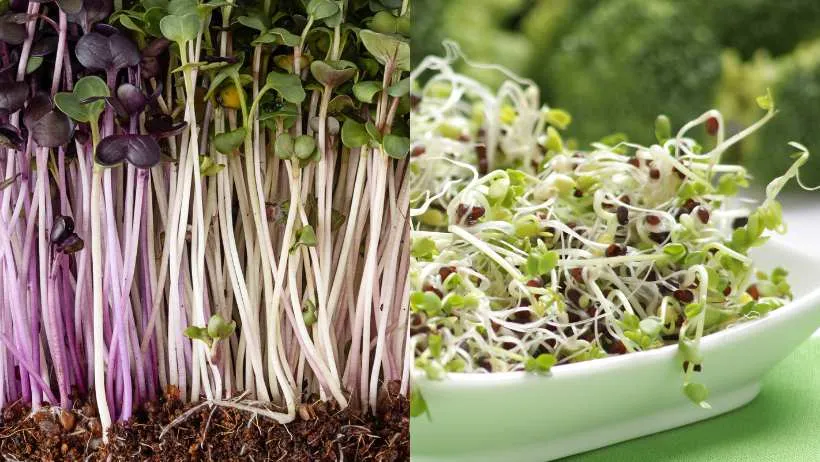Microgreens are more than just a trendy garnish—they are packed with nutrients, often exceeding those found in mature vegetables. Research from the USDA and the University of Maryland shows that microgreens can contain several times more vitamins and antioxidants than their fully grown counterparts.
These tiny greens are loaded with vitamins A, C, E, and K, essential minerals like iron and potassium, and powerful plant compounds like sulforaphane, which have been linked to cancer prevention. Their high nutrient density and easy integration into meals make them a practical superfood.
This guide explains exactly why microgreens stand out nutritionally and how they compare to mature greens. It provides the facts you need to make informed dietary choices.
What Are Microgreens?
Microgreens are young, edible greens harvested at the cotyledon stage, just after the first true leaves appear. They are grown from vegetable, herb, or grain seeds and are typically harvested within 7–21 days after germination. Unlike sprouts, microgreens grow in soil or hydroponic systems and are cut above the root. These greens are nutrient-dense, containing high levels of vitamins, minerals, and antioxidants. Studies show they can have up to 40 times more nutrients than mature plants, making them a highly concentrated source of essential micronutrients.
Their popularity has surged due to their concentrated flavors, vibrant colors, and impressive nutritional profile. Restaurants and home cooks use them to enhance dishes with taste and visual appeal.
Why Are Microgreens Considered a Superfood?
Microgreens earn their superfood status due to their exceptional nutrient density. Studies have shown they can contain significantly higher concentrations of vitamins, minerals, and antioxidants than their mature counterparts. This makes them an efficient way to boost nutrient intake without consuming large portions. Many varieties, such as broccoli, red cabbage, and mustard microgreens, are particularly rich in compounds like sulforaphane and polyphenols, which have been linked to reduced inflammation, improved heart health, and even cancer prevention.
Microgreens’ versatility and ease of incorporation into meals further add to their appeal. Unlike superfoods that require special preparation, they can be added raw to salads, sandwiches, soups, and smoothies, ensuring maximum nutrient retention. They are also easy to grow at home, making them a fresh and accessible source of nutrition year-round. With their combination of concentrated health benefits and culinary flexibility, microgreens are a nutrient powerhouse supporting overall well-being in just a small serving.
A Closer Look at Their Nutritional Profile
Microgreens pack a dense concentration of vitamins, minerals, and antioxidants, often exceeding the levels found in their fully grown counterparts. These tiny greens are particularly rich in vitamins C, E, and K, all of which play essential roles in immune function, skin health, and blood clotting. Many varieties, such as red cabbage and cilantro microgreens, are loaded with beta-carotene, a precursor to vitamin A that supports vision and cellular health.
Microgreens also contain minerals like potassium, iron, zinc, and magnesium, which help with muscle function, oxygen transport, and overall metabolic processes. In addition, microgreens contain a range of polyphenols and flavonoids—powerful antioxidants that protect cells from damage caused by free radicals. Some studies suggest that these compounds may help reduce the risk of chronic diseases, including heart disease and certain cancers.
Another reason broccoli and mustard microgreens stand out nutritionally is the presence of sulforaphane, a potent plant compound linked to anti-cancer properties. It may support detoxification processes in the body. With their rich nutrient profile, microgreens provide a concentrated source of essential health-boosting compounds in just a small serving.
Microgreens Nutrition Facts: How Do They Compare?
Microgreens have been widely recognized for their higher nutrient density than mature greens. Research from the U.S. Department of Agriculture (USDA) and the University of Maryland found that certain microgreens contain up to 40 times more vitamins and antioxidants than their fully grown counterparts. For example, red cabbage microgreens had significantly higher vitamin C and beta-carotene levels than mature red cabbage. Similarly, cilantro and garnet amaranth microgreens were particularly rich in lutein and vitamin E, which support eye and skin health.
The reason for this higher nutrient content lies in their growth stage. During the early phases of development, plants concentrate essential nutrients to fuel their growth, leading to a more potent nutritional profile in their microgreen stage. While mature greens like spinach and kale are still excellent sources of vitamins and minerals, consuming microgreens allows for a higher intake of beneficial compounds in a much smaller serving size.
However, nutrient levels vary by type, growing conditions, and harvesting time. While most microgreens outperform their mature versions in nutrient density, they should be part of a balanced diet rather than a sole source of nutrition. Their concentrated benefits make them an excellent addition to meals, boosting the overall nutritional value of a dish.
Microgreens Health Benefits: How They Benefit Your Health
Are microgreens healthy? Due to their concentrated nutrient content, microgreens offer various health benefits. Their high levels of vitamins A, C, and K support immune function, skin health, and proper blood clotting. The antioxidants in microgreens, such as polyphenols and carotenoids, help protect cells from oxidative stress, reducing the risk of chronic diseases like heart disease and cancer.
Their fiber content aids digestion by promoting gut health and supporting beneficial bacteria in the microbiome. Certain varieties, like broccoli and mustard microgreens, contain sulforaphane, a compound linked to reduced inflammation and potential cancer-fighting properties. Protein-rich microgreens such as peas and sunflowers also provide essential amino acids for muscle repair and overall body function.
Because they are low in calories and carbohydrates, microgreens fit well into various diets, from keto to plant-based eating plans. Adding them to daily meals can boost your nutrient intake without extra effort, making them a simple yet powerful addition to a healthy lifestyle.
Protein Power: Which Varieties Stand Out?
While microgreens are not typically considered a primary protein source, some varieties contain notable amounts that can contribute to muscle repair, immune function, and overall nutrition. The most protein-rich options are sunflower, pea, lentil, and amaranth microgreens. Sunflower microgreens, for example, provide a well-balanced profile of essential amino acids, making them a valuable plant-based protein source. Pea microgreens also offer about 20–25% protein by weight, fiber, and essential vitamins.
Lentil microgreens are another excellent choice, containing all nine essential amino acids needed for muscle growth and recovery. Amaranth microgreens, known for their vibrant color and slightly earthy flavor, pack a high protein content and beneficial micronutrients like iron and calcium. Adding these microgreens to meals can help increase protein intake, particularly for those following plant-based diets. They can be incorporated into salads, smoothies, and wraps, offering a nutrient-dense boost without the need for excessive calories.
Carbohydrates in Microgreens: What to Expect
Microgreens contain a small amount of carbohydrates, making them a low-carb addition to any diet. Their carbohydrate content primarily comes from natural sugars and fiber, providing a mild energy boost without causing significant blood sugar spikes. The exact carbohydrate levels vary by type, but most microgreens contain 1 to 4 grams of carbs per serving, making them suitable for keto, low-carb, and diabetic-friendly diets.
Leafy microgreens like arugula, kale, and spinach have minimal carbs, while slightly starchier options like pea and sunflower microgreens contain slightly more due to their higher fiber content. However, because microgreens are usually eaten in small quantities, their impact on daily carbohydrate intake is negligible. Instead, they provide a variety of vitamins, minerals, and antioxidants without excess sugars or starches. Their fiber content also plays a role in digestion and gut health, making them a smart choice for balanced nutrition.
Supporting Gut Health: Do They Act as Prebiotics?
Microgreens contribute to gut health by providing fiber, antioxidants, and plant compounds that support digestion. While they are not a direct prebiotic like bananas or onions, their fiber content helps feed beneficial gut bacteria. This supports a balanced microbiome, which plays a role in digestion, immune function, and mood regulation. Pea and sunflower microgreens, in particular, contain soluble fiber, which helps slow digestion and promotes healthy gut bacteria growth.
In addition to fiber, microgreens are rich in polyphenols—plant compounds that act as antioxidants and may help reduce inflammation in the gut. Studies suggest that polyphenols can promote the growth of good bacteria while inhibiting harmful strains. Some microgreens, like radish and mustard, contain natural enzymes that aid digestion by breaking down food more efficiently. Incorporating microgreens into daily meals can naturally support gut health while benefiting from their dense nutritional profile.
Anti-Inflammatory Properties: Fact or Fiction?
Microgreens contain various compounds that may help reduce inflammation in the body. Rich in antioxidants like polyphenols, flavonoids, and carotenoids, they help neutralize free radicals that contribute to chronic inflammation. Research has shown that microgreens, especially those from the brassica family—such as broccoli, kale, and mustard—contain sulforaphane, a compound linked to lower inflammation and potential cancer-fighting properties.
Studies suggest that polyphenols found in microgreens can help reduce markers of inflammation, which are associated with conditions like heart disease, arthritis, and diabetes. Red cabbage microgreens, for example, have been shown to lower levels of LDL cholesterol and oxidative stress in animal studies, suggesting potential heart health benefits. While microgreens alone may not cure inflammatory conditions, their nutrient-dense composition can support an anti-inflammatory diet. Regular consumption alongside other whole foods may contribute to reduced inflammation and overall improved health.
Cooking and Nutrient Retention
Microgreens are best consumed raw to preserve their high levels of vitamins and antioxidants. Heat can break down delicate nutrients like vitamin C and certain polyphenols, reducing nutritional value. Eating them fresh in salads, sandwiches, smoothies, or as a garnish helps maintain their full benefits. However, some nutrients, such as beta-carotene and certain antioxidants, may become more bioavailable when lightly cooked.
If you incorporate microgreens into warm dishes, add them at the end of cooking. Stirring them into soups or pasta just before serving helps retain more nutrients while enhancing flavor. Steaming or lightly wilting certain varieties, like pea or sunflower microgreens, can soften their texture without significant nutrient loss. Blending them into pesto or dressings is another way to enjoy their benefits while protecting sensitive vitamins. To maximize their nutritional impact, combining raw and lightly cooked microgreens in meals can offer the best of both worlds.
References
- Microgreens – Wikipedia
- Benefits of Microgreens – Microgreens World
- Microgreens Nutrition – Verywell Health
- Polyphenols and Health Benefits – PMC
- Sulforaphane Benefits – Healthline
- Comparison of Microgreens and Mature Plants – ResearchGate
- Nutrient Differences Between Microgreens and Mature Vegetables – ACS
- Mighty Microgreens – agnr.umd.edu
- Health Benefits of Broccoli Sprouts – WebMD
- Nutrient Content of Micro/Baby-Green – PMC
- Microgreen Study Shows Health Benefits – USDA







